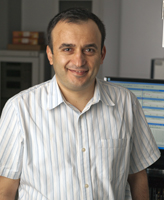Dr. Ramazan Demirli Presents Tutorial at IEEE International Ultrasonics Symposium

Dr. Ramazan Demirli, Director of the Acoustics and Ultrasound Laboratory within the Center for Advanced Communications, presented a tutorial aimed at helping engineers and researchers overcome key signal processing problems associated with ultrasonic imaging and testing at the IEEE’s annual International Ultrasonics Symposium in October, held this year in San Diego, Calif.
“I was pleased to represent Villanova and the CAC, and to share our expertise, at such an important gathering for the ultrasonics community,” says Dr. Demirli, who also served as a technical committee member for the symposium. His presentation attracted researchers and engineers from a wide range of ultrasonics disciplines, such as nondestructive testing and imaging, medical ultrasound, and acoustic signal communications.
Through his tutorial, entitled “Ultrasonic Signal Processing for Detection, Estimation and Compression,” Dr. Demirli highlighted recent advances and emerging signal processing techniques in ultrasonic imaging and testing, such as parametric modeling and estimation for target localization and classification, sparse signal representations for ultrasonic target identification, and data compression.
He also addressed some of the key signal processing problems common to many ultrasonic imaging and testing applications, such as target echo identification in the presence of ultrasound speckle, modeling and exploitation of reverberation echoes, and deconvolution for improving ultrasound image resolution.
Dr. Demirli is involved with the CAC’s current research and development into the advancement of acoustic and ultrasound technologies for the medical and industrial communities, funded by a $600,000, two-year Partnerships for Innovation grant from the National Science Foundation. The goal of this research is to develop solutions to improve diagnostics of anomalies found in human tissues and organs, as well as cracks and fractures in machine structures, by enhancing the ability to detect, localize, and classify abnormalities in ultrasound signals and images.
